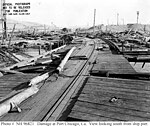Grizzly Bay
Bays of CaliforniaBays of San Francisco BayBodies of water of Solano County, CaliforniaLandforms of the San Francisco Bay AreaSan Francisco Bay Area geography stubs ... and 1 more
Tributaries of San Pablo Bay
Grizzly Bay is a baylet of the San Francisco Bay, and an extension of Suisun Bay, which dips into Solano County, California. Grizzly Bay contains many sloughs, wildlife areas, and islands such as Grizzly Island, Joice Island and Morrow Island. It is also home to the Fifth Reserve Fleet, which is docked off the coast of Benicia. Suisun Slough and Cordelia Slough empty into Grizzly Bay.
Excerpt from the Wikipedia article Grizzly Bay (License: CC BY-SA 3.0, Authors).Grizzly Bay
Geographical coordinates (GPS) Address Nearby Places Show on map
Geographical coordinates (GPS)
| Latitude | Longitude |
|---|---|
| N 38.116666666667 ° | E -122.03333333333 ° |
Address
Solano County (Solano)
California, United States
Open on Google Maps









